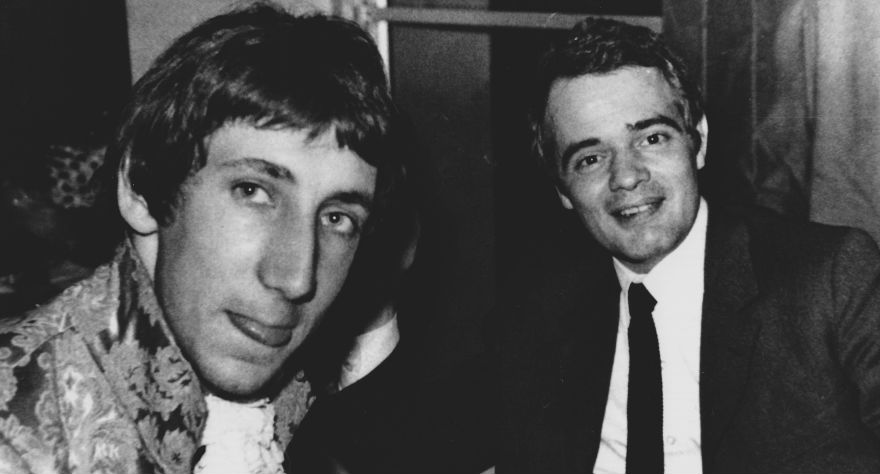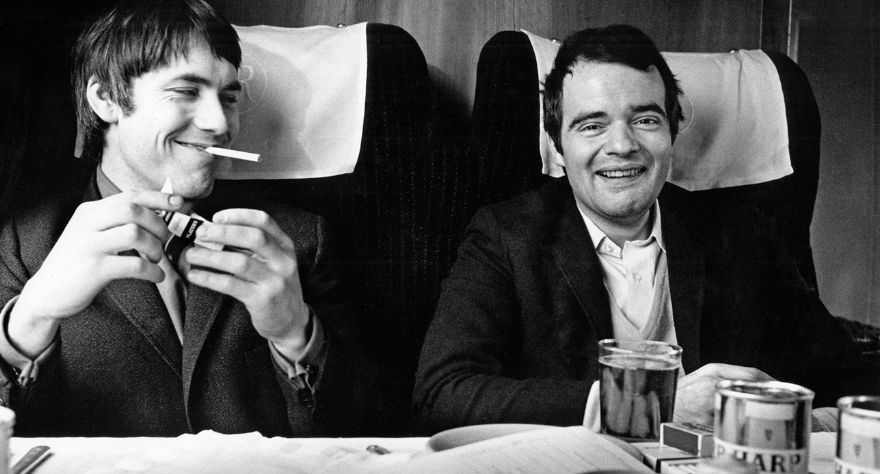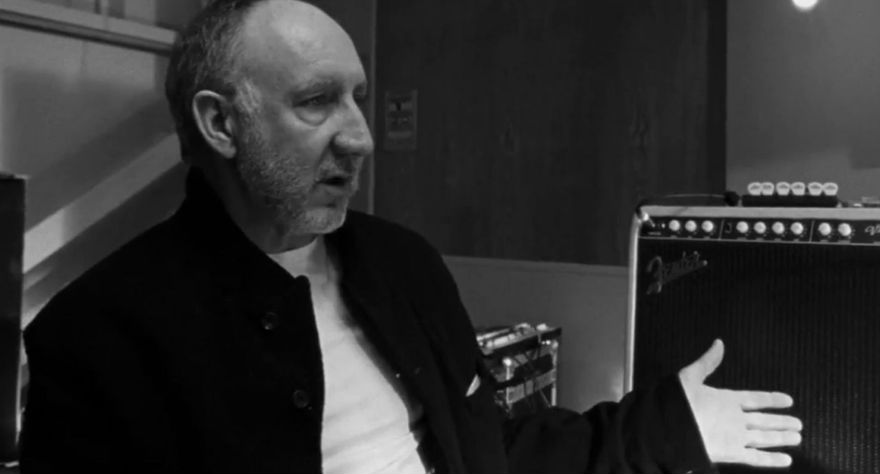James D. Cooper On ‘Lambert & Stamp’, the Virtue of Vulnerability

James D. Cooper’s 10-years-in-the-making documentary, Lambert & Stamp, chronicles the longtime partnership of Kit Lambert and Chris Stamp, a couple of aspiring filmmakers who accidentally helped kickstart one of the most vital bands in rock history. Fans of the French New Wave, the unlikely English duo went in search of a band they could use as the centerpiece for their first film. They wound up finding a group of unattractive fellows that called themselves The High Numbers. Years later, they’d be known to the world as The Who.
Energetic, raucous, and unexpectedly tender, Lambert & Stamp is a rock doc not so much about the music as it is about two friends who forged the relationship of a lifetime. Nevertheless, fans of The Who will undoubtedly leave the theater satisfied, as the band’s presence is represented by electric archival footage and brand new interviews with Pete Townshend and Roger Daltrey.
Cooper took time to speak with us about the film’s 10-year journey to the big screen, his background in cinematography, shooting on Super 16, giving the film a psychological dimension, why L&S is a great date movie, the darker side of Keith Moon, and much more.
Lambert & Stamp is out in limited release now.

It’s pretty amazing that the film is ten years in the making.
Yeah, that’s about how long it took. It’s nice now to be in a position to turn it over to its rightful owners, which is the audience.
Even though it took ten years to make, I think the advantage of this kind of film is that it’s kind of a time capsule of the past anyway. Did you find that helpful?
We certainly took advantage of the things that happened over time, particularly with Christ Stamp. While all his years with Kit and The Who were brilliant and cathartic, they were ultimately tragic and painful. There was a lot I had to put him through in telling the story. He was in a different area of his life when we came to him to do the film. It took some time for me to work with him and get the full arch and embody his emotional connection to the story. Also, there are things that happened as a result of time, like the beautiful dedication Roger Daltrey did, which happened six to eight years after we started filming. When films go according to their own plan as opposed to your plan, you adjust and make it work.
Did your background as a cinematographer help you to be adaptable in that way?
Oh yes. Absolutely. All the planning, all the visual conceptualizing as a cinematographer only helps you to be spontaneous in the process when things don’t go according to plan, which of course they never do. You’re able to respond. Being a cinematographer also helped me on this film because I was able to design the production around my own needs. I knew exactly what I wanted and how to approach things. I was able to go to the production very specifically and not run around and scatter about. I knew the approach I wanted to take.
You shot on Super 16, right?
Yeah. It was amazing. We always wanted this to be a theatrical release, and I wanted to be able to work spontaneously. There’s something about hearing the film go through the camera mag while I’m filming. There’s a certain organic-ness to it. This project was right to shoot on film, although it was seen as insane. Like I said, my background as a cinematographer helped, so pretty much every scene I shot for the film ended up in there. A lot of film we were using was shot on film in the ’60s and ’70s, and I didn’t want to make a film that looked reflective by shooting on digital. I wanted a seamless, timeless film without tense.
Sometimes when a doc that uses archival footage is shot on digital, it feels like we’re looking back when we see the old footage as opposed to living in it.
Right. I wanted the viewers to feel at the center of a current, ongoing reality. Film was perfect for that.
Did Chris and Kit’s taste in film influence how you made your film?
Jumping back a bit, when my partner Loretta Harms and I approached Chris Stamp to do the film, his immediate response was, “If you were to do this, the film you’re talking about making is the continuation of the film Kit and I set out to make.” I knew Chris and he knew me as a young cinematographer, and I loved a lot of the stuff he loved, like The French New Wave. It’s not that I shot the film with an intended style, I just married it to the emotional content of what was happening. I really know how to trick the film itself to give a certain psychological effect. I used a lot of camera burnouts and other things to give a psychological dimension that was a bit of a time portal, and also to show the process of filmmaking as a character in the film. In a sense, yeah, I think there’s an extension of Chris and Kit in there somehow.
Today, people are obsessed with documenting every second of their life. Back in the ’60s and ’70s, that was much more of a rarity, so the fact that all this footage of Kit and Chris and The Who exists is something of a treasure. Was it an emotional experience watching the footage?
Not to un-romanticize it, but for me it was just technical problem solving. [laughs] It was about what was going to be essential to the narrative. The first thing was the film Chris and Kit shot of the early High Numbers, because I wanted to have the viewer the point of view that they were going for in their endeavor to make this film. It’s really interesting footage. Then I had to figure out how to represent Kit Lambert, who’s no longer with us. It’s a narrative problem. But thankfully, a lot of footage was shot of Chris and Kit back then. I liken the process to art direction in a feature film. I surrounded the story with support material that I didn’t exactly want to be representational as much as a living character, so it had to have the right tonality and mise en scéne to convey the story. I didn’t use footage for the sake of it being rare; it had to poetically fit the persistence of vision scene to scene.
A lot of the time, documentarians let the footage dictate the storytelling, but here it seems you’ve done the opposite and used the footage as a pool of memories to pull from.
Yeah, it was completely opposite from the normal approach. It was more the rare and untold story I was after, as opposed to the rare and unseen footage. I thought I had a really interesting formal challenge and a story that worked on many levels, so finding the stuff to support that was a matter of would work. I wanted to convey the emotional essence of the story, rather than just go, “Here’s a picture of what we’re talking about.”

I loved the musicality of the editing.
I didn’t want to use somebody who came from documentary filmmaking; I wanted to work with someone who would understand what I wanted in terms of a character arc. Christopher Tellefsen had a very eclectic filmography, and a very artistic way of translating the essence of what we wanted. First of all, it’s emulating French New Wave somewhat, which used a lot of things coming in at right angles and sideways, and a lot of times we’d jam images in there to give the viewer the illusion that they were present in the process. Processes are messy; they’re not all refined. We were very physical with how we used the images. I’m grateful that I was able to work with somebody who was so willing to take this approach with me on a non-fiction film.
I don’t know if you’ll agree or disagree with me, but I think this is a great date movie.
When people ask me about my film, I say it’s a love story. It is a great date movie. I agree wholeheartedly. At the center of the film is personal vulnerability. I get a lot of people who come into it from the music point of view seeing an unknown story about the band, but there’s also a fragile, emotional center.
Even though the aesthetics of the film are, like you said, very physical and tactile, I think there’s a tenderness to it that’ll creep up on people.
Thank you for mentioning that. I think toward the end of the film, where Chris Stamp talks about how the whole thing is about love and a that love is complicated, it really shows you the vulnerable, sensitive place you’re in when you go into relationships. I think willingness and acceptance of one another is in this film a lot.
There’s footage in the film of the boys in the band and Chris and Kit having these creative conversations, where they’re talking about chords and melodies and arrangements. I love seeing candid footage like that of bands going through the creative process. Can you remember having a great creative conversation that impacted you as an artist?
For about ten years with my production team making this movie! [laughs] A lot of it was great and fun and cathartic, but it was a complicated film to try to make. A lot of times me and Chris Tellefsen would be in the editing room late, and Loretta Harms would be working in the next room. She’d say, “Why are you guys laughing so hard?!” It would just be because of the release we got through the creative process. We’d just laugh hysterically, and it was really great.
I love the conversation you shot between Roger and Pete talking about Keith.
I both directed and shot that scene. It was amazing just falling in with the filming. What’s interesting about that whole thing is, we know Keith Moon in a certain way, but a lot of people don’t realize that there was a real darkness going on in this person. It really shows what’s on the inside and what’s behind the curtain as opposed to what the public can make into something. I felt incredible to be a part of that and many of the other ongoing conversations that made this thing work at its core.
What’s your idea of pure happiness?
My idea of pure happiness is being able to be completely in the moment, as open and available as possible.
